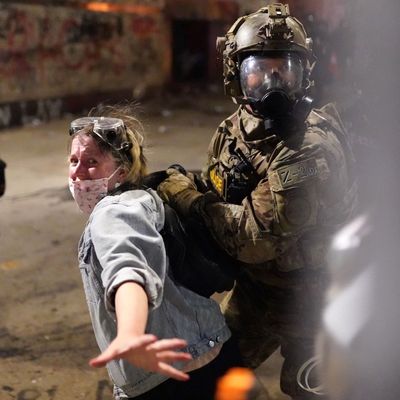
Donald Trump’s plan for exciting his base during the 2018 midterm elections was to crank up the threat of a migrant caravan. Fox News ran caravan footage on endless loop, and Trump smashed democratic norms by using the military as a campaign prop, deploying it to the border to “defend” against the supposed threat of violence (which, of course, magically dissipated immediately after the election.)
Trump’s party obviously fared terribly in the midterms, as one would expect from a deeply unpopular president. But he did crank up historically high levels of Republican turnout, and was hardly mistaken in seeing the tactic as a success.
The caravan episode has become the model for Trump’s reelection strategy. Trump hypes the threat from a small band of telegenic miscreants who may pose no threat to the average person, but look scary enough in a tightly framed video clip, and whom he can link to his opponent and promise to brutalize. In this case, the enemy is small bands of vandals that have lingered at the tail end of the George Floyd demonstrations. Trump has used the danger to justify a surge of federal troops in the hope that they would create footage of confrontations that would present Trump as the heroic vanquisher of chaos, this time inside America’s borders.
An administration official recently told the Washington Post the White House “had long wanted to amplify strife in cities,” and that “it was about getting viral online content.” A confession that the president is provoking violent confrontations on American soil in order to seed campaign propaganda would tear apart a normal presidency, but has already been half-forgotten against the backdrop of an administration in which scandals of this scale occur several times a week.
And yet Trump’s ploy has not worked at all. Indeed, he and his supporters have been reduced to complaining that the biased news media is showing images of nonviolent protesters rather than the troops-versus-anarchist battles Trump longs to put on display.
Conservatives do have a germ of a point: Some of the protesters, especially in Portland, have destroyed or defaced property and provoked police, rather than merely demonstrating against racism and police violence. The Portland NAACP complained that “mostly white anarchists” have incited violence and diverted attention from the purpose of the protests.
But the reason Trump’s tactic fails is that, by deploying troops to fight the anarchists, he broadens the issue into a fight about Trump himself. This inevitably draws more, largely nonviolent protesters into the streets. “The numbers of protesters had dwindled substantially in recent weeks,” one reporter in Portland observed last week, “but reports of heavily armed, unidentified, camouflaged federal officers abducting people off the street into unmarked vehicles and meting out violence on the people of Portland have thoroughly re-energized the populace.”
The same thing happened further north. “Nightly protests since the police killing of George Floyd in Minneapolis had dwindled in recent weeks in Seattle but were reinvigorated in the wake of federal action in the Portland protests and after Washington Gov. Jay Inslee (D) tweeted that President Trump had sent federal law enforcement agents to the city,” reported the Post.
And so the scenes that Trump craves, pitting soldiers against black-clad radicals, have transformed quickly into troops against veterans, moms, and other antagonists who cut a more sympathetic profile. The protesters report that they have joined the protests because of Trump’s response to the protests. Tessa and Leshan Terry formed the “Wall of Vets” in Portland, and came to their first demonstration, after seeing video of agents beating a fellow Navy veteran.
Peter Hamby recently found polling that showed Trump’s approval dropped precipitously following the battle of Lafayette Square. And it was not just Trump’s approval or vote share against Joe Biden that collapsed. The episode triggered a sharp change in public attitudes toward the police. As the political scientist Omar Wasow has found for the 1960s, nonviolent protests increased support for civil rights, even as violent protests diminished it. The first few days of the protests combined both violent and nonviolent protests, but eventually larger peaceful demonstrations dominated the scene. It was likely the violence used by police against peaceful demonstrators that turned public opinion decisively — not only on Trump, but also the reality of abusive policing that was on such vivid display.
Trump wishes to frame the election as a conflict between himself and anarchists. But the very act of inserting himself into the conflict changes its nature. Trump’s strategy is failing because he thought he could isolate a static enemy. He wanted to beat up on a new caravan. This time, though, the caravan is all of us.






























